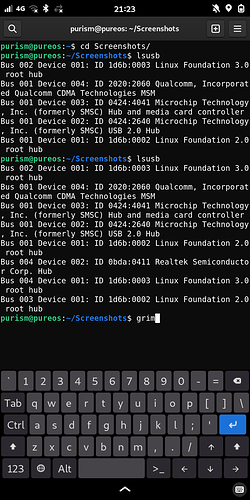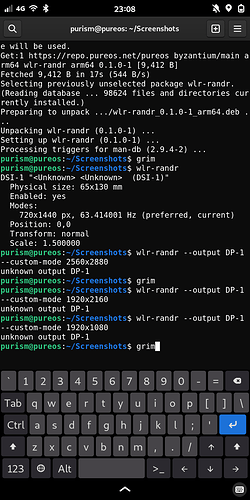The monitor is the LG 28MQ780-B, the only monitor that currently goes under the name of DualUp. I attempted to use it over USB-C, as it is the only USB-C monitor I have available and my Librem 5 is the only device I have available that can output over USB-C. By “doesn’t work” I mean that I was not able to get the phone to visibly recognise it as a display output; when plugging it in, the monitor says “No signal”. I wish I knew a command to debug what types of display it’s connected to – I have no idea what type of protocol this monitor uses, just that is supports “USB-C” and has a port and input for it. I think that the most likely reason it does not work is either that the monitor uses a protocol the phone does not support, or because it has a very tall and uncommon resolution of 2560x2880. lsusb output (screenshot at 150% scaling):
The dmesg output is pretty interesting. It has many messages about enabling and disabling the OTG pin, and within that wall of text includes:
[14049.918484] usb 3-1: new high-speed USB device number 2 using xhci-hcd
[14050.089429] usb 3-1: New USB device found, idVendor=0bda, idProduct=5411, bcdDevice= 2.03
[14050.089455] usb 3-1: New USB device strings: Mfr=1, Product=2, SerialNumber=0
[14050.089461] usb 3-1: Product: USB2.1 Hub
[14050.089466] usb 3-1: Manufacturer: Generic
[14050.089916] usb 3-1: Device is not authorized for usage
[14050.147596] hub 3-1:1.0: USB hub found
[14050.148779] hub 3-1:1.0: 5 ports detected
[14050.213105] usb 3-1: authorized to connect
[14050.351626] bq25890-charger 3-006a: Upstream supply changed: 1.
[14050.351656] bq25890-charger 3-006a: Disabling OTG_EN pin
[14050.494221] bq25890-charger 3-006a: NTC state UNKNOWN
[14050.503936] usb 3-1.3: new full-speed USB device number 3 using xhci-hcd
[14050.553836] bq25890-charger 3-006a: NTC state normal
[14050.607689] usb 3-1.3: New USB device found, idVendor=043e, idProduct=9a39, bcdDevice= 4.18
[14050.607713] usb 3-1.3: New USB device strings: Mfr=1, Product=3, SerialNumber=4
[14050.607719] usb 3-1.3: Product: LG Monitor Controls
[14050.607724] usb 3-1.3: Manufacturer: LG Electronics Inc.
[14050.607729] usb 3-1.3: SerialNumber: 210NTTQ4H481
[14050.608185] usb 3-1.3: Device is not authorized for usage
[14050.621624] bq25890-charger 3-006a: NTC state UNKNOWN
[14050.629987] bq25890-charger 3-006a: NTC state normal
[14050.633183] bq25890-charger 3-006a: Upstream supply changed: 1.
[14050.633205] bq25890-charger 3-006a: Disabling OTG_EN pin
[14050.691062] usb 3-1.3: authorized to connect
[14050.702513] usb 3-1.4: new full-speed USB device number 4 using xhci-hcd
[14050.743282] bq25890-charger 3-006a: Upstream supply changed: 1.
[14050.743309] bq25890-charger 3-006a: Disabling OTG_EN pin
[14050.754034] hid-generic 0003:043E:9A39.0001: hiddev96,hidraw0: USB HID v1.11 Device [LG Electronics Inc. LG Monitor Controls] on usb-xhci-hcd.5.auto-1.3/input0
[14050.757092] usbcore: registered new interface driver usbhid
[14050.757111] usbhid: USB HID core driver
[14050.804960] usb 3-1.4: not running at top speed; connect to a high speed hub
[14050.808081] usb 3-1.4: New USB device found, idVendor=043e, idProduct=9c09, bcdDevice= 0.0a
[14050.808106] usb 3-1.4: New USB device strings: Mfr=17, Product=18, SerialNumber=19
[14050.808113] usb 3-1.4: Product: BillBoard Device
[14050.808118] usb 3-1.4: Manufacturer: Realtek
[14050.808123] usb 3-1.4: SerialNumber: 123456789ABCDEFGH
[14050.808601] usb 3-1.4: Device is not authorized for usage
[14050.823377] usb 3-1.4: authorized to connect
[14051.684742] bq25890-charger 3-006a: Upstream supply changed: 1.
[14051.684773] bq25890-charger 3-006a: Disabling OTG_EN pin
[14051.817637] bq25890-charger 3-006a: NTC state UNKNOWN
[14051.873963] bq25890-charger 3-006a: NTC state normal
[14051.950305] bq25890-charger 3-006a: NTC state UNKNOWN
[14051.958247] bq25890-charger 3-006a: NTC state normal
[14051.964952] bq25890-charger 3-006a: Upstream supply changed: 1.
[14051.964977] bq25890-charger 3-006a: Disabling OTG_EN pin
And after many more messages enabling and disabling OTG:
[14449.834830] tps6598x 0-003f: The interrupt is masked , how did it fire ?? 380100a
[14449.843169] bq25890-charger 3-006a: Upstream supply changed: 0.
[14449.843190] bq25890-charger 3-006a: Disabling OTG_EN pin
[14449.846631] bq25890-charger 3-006a: Upstream supply changed: 0.
[14449.846651] bq25890-charger 3-006a: Disabling OTG_EN pin
[14449.862579] xhci-hcd xhci-hcd.5.auto: xHCI Host Controller
[14449.862612] xhci-hcd xhci-hcd.5.auto: new USB bus registered, assigned bus number 3
[14449.862725] xhci-hcd xhci-hcd.5.auto: hcc params 0x0220fe6c hci version 0x110 quirks 0x0000000000010010
[14449.862769] xhci-hcd xhci-hcd.5.auto: irq 207, io mem 0x38100000
[14449.862893] xhci-hcd xhci-hcd.5.auto: xHCI Host Controller
[14449.862904] xhci-hcd xhci-hcd.5.auto: new USB bus registered, assigned bus number 4
[14449.862915] xhci-hcd xhci-hcd.5.auto: Host supports USB 3.0 SuperSpeed
[14449.863000] bq25890-charger 3-006a: Upstream supply changed: 0.
[14449.863011] bq25890-charger 3-006a: Disabling OTG_EN pin
[14449.863199] usb usb3: New USB device found, idVendor=1d6b, idProduct=0002, bcdDevice= 6.03
[14449.863208] usb usb3: New USB device strings: Mfr=3, Product=2, SerialNumber=1
[14449.863214] usb usb3: Product: xHCI Host Controller
[14449.863220] usb usb3: Manufacturer: Linux 6.3.0-1-librem5 xhci-hcd
[14449.863225] usb usb3: SerialNumber: xhci-hcd.5.auto
[14449.863846] hub 3-0:1.0: USB hub found
[14449.863895] hub 3-0:1.0: 1 port detected
[14449.864261] usb usb4: We don't know the algorithms for LPM for this host, disabling LPM.
[14449.864406] usb usb4: New USB device found, idVendor=1d6b, idProduct=0003, bcdDevice= 6.03
[14449.864415] usb usb4: New USB device strings: Mfr=3, Product=2, SerialNumber=1
[14449.864422] usb usb4: Product: xHCI Host Controller
[14449.864427] usb usb4: Manufacturer: Linux 6.3.0-1-librem5 xhci-hcd
[14449.864433] usb usb4: SerialNumber: xhci-hcd.5.auto
[14449.864948] hub 4-0:1.0: USB hub found
[14449.864994] hub 4-0:1.0: 1 port detected
[14449.865443] xhci-hcd xhci-hcd.5.auto: remove, state 1
[14449.865458] usb usb4: USB disconnect, device number 1
[14449.866116] bq25890-charger 3-006a: Upstream supply changed: 0.
[14449.866149] bq25890-charger 3-006a: Disabling OTG_EN pin
[14449.869753] xhci-hcd xhci-hcd.5.auto: USB bus 4 deregistered
[14449.869787] xhci-hcd xhci-hcd.5.auto: remove, state 1
[14449.869802] usb usb3: USB disconnect, device number 1
[14449.881177] xhci-hcd xhci-hcd.5.auto: USB bus 3 deregistered
[14449.904983] bq25890-charger 3-006a: NTC state UNKNOWN
[14449.935814] bq25890-charger 3-006a: Upstream supply changed: 1.
[14449.935938] bq25890-charger 3-006a: Disabling OTG_EN pin
[14449.938773] bq25890-charger 3-006a: Upstream supply changed: 1.
[14449.938797] bq25890-charger 3-006a: Disabling OTG_EN pin
[14449.945649] bq25890-charger 3-006a: Upstream supply changed: 1.
[14449.945673] bq25890-charger 3-006a: Disabling OTG_EN pin
[14449.947735] bq25890-charger 3-006a: NTC state normal
[14449.986516] bq25890-charger 3-006a: Upstream supply changed: 1.
[14449.986539] bq25890-charger 3-006a: Disabling OTG_EN pin
[14450.142365] bq25890-charger 3-006a: Upstream supply changed: 1.
[14450.142391] bq25890-charger 3-006a: Disabling OTG_EN pin
[14450.148118] bq25890-charger 3-006a: Upstream supply changed: 1.
[14450.148148] bq25890-charger 3-006a: Disabling OTG_EN pin
[14450.221238] bq25890-charger 3-006a: NTC state UNKNOWN
[14450.232793] bq25890-charger 3-006a: NTC state normal
[14450.242962] bq25890-charger 3-006a: NTC state UNKNOWN
[14450.253707] bq25890-charger 3-006a: Upstream supply changed: 1.
[14450.253732] bq25890-charger 3-006a: Disabling OTG_EN pin
[14450.297884] bq25890-charger 3-006a: NTC state normal
[14450.551337] bq25890-charger 3-006a: Upstream supply changed: 1.
[14450.551367] bq25890-charger 3-006a: Disabling OTG_EN pin
[14450.670577] xhci-hcd xhci-hcd.5.auto: xHCI Host Controller
[14450.670610] xhci-hcd xhci-hcd.5.auto: new USB bus registered, assigned bus number 3
[14450.670728] xhci-hcd xhci-hcd.5.auto: hcc params 0x0220fe6c hci version 0x110 quirks 0x0000000000010010
[14450.670771] xhci-hcd xhci-hcd.5.auto: irq 207, io mem 0x38100000
[14450.670889] xhci-hcd xhci-hcd.5.auto: xHCI Host Controller
[14450.670902] xhci-hcd xhci-hcd.5.auto: new USB bus registered, assigned bus number 4
[14450.670913] xhci-hcd xhci-hcd.5.auto: Host supports USB 3.0 SuperSpeed
[14450.670996] bq25890-charger 3-006a: Upstream supply changed: 1.
[14450.671005] bq25890-charger 3-006a: Disabling OTG_EN pin
[14450.671139] usb usb3: New USB device found, idVendor=1d6b, idProduct=0002, bcdDevice= 6.03
[14450.671148] usb usb3: New USB device strings: Mfr=3, Product=2, SerialNumber=1
[14450.671155] usb usb3: Product: xHCI Host Controller
[14450.671160] usb usb3: Manufacturer: Linux 6.3.0-1-librem5 xhci-hcd
[14450.671164] usb usb3: SerialNumber: xhci-hcd.5.auto
[14450.676607] hub 3-0:1.0: USB hub found
[14450.676657] hub 3-0:1.0: 1 port detected
[14450.679470] usb usb4: We don't know the algorithms for LPM for this host, disabling LPM.
[14450.679646] usb usb4: New USB device found, idVendor=1d6b, idProduct=0003, bcdDevice= 6.03
[14450.679657] usb usb4: New USB device strings: Mfr=3, Product=2, SerialNumber=1
[14450.679663] usb usb4: Product: xHCI Host Controller
[14450.679669] usb usb4: Manufacturer: Linux 6.3.0-1-librem5 xhci-hcd
[14450.679673] usb usb4: SerialNumber: xhci-hcd.5.auto
[14450.681310] hub 4-0:1.0: USB hub found
[14450.681354] hub 4-0:1.0: 1 port detected
[14450.682843] bq25890-charger 3-006a: Upstream supply changed: 1.
[14450.682865] bq25890-charger 3-006a: Disabling OTG_EN pin
[14451.018483] usb 4-1: new SuperSpeed USB device number 2 using xhci-hcd
[14451.048688] usb 4-1: New USB device found, idVendor=0bda, idProduct=0411, bcdDevice= 2.03
[14451.048710] usb 4-1: New USB device strings: Mfr=1, Product=2, SerialNumber=0
[14451.048717] usb 4-1: Product: USB3.2 Hub
[14451.048722] usb 4-1: Manufacturer: Generic
[14451.049134] usb 4-1: Device is not authorized for usage
[14451.088048] hub 4-1:1.0: USB hub found
[14451.089464] hub 4-1:1.0: 2 ports detected
[14451.094552] usb 4-1: authorized to connect
[14451.195237] bq25890-charger 3-006a: Upstream supply changed: 1.
[14451.195263] bq25890-charger 3-006a: Disabling OTG_EN pin
[14451.338096] bq25890-charger 3-006a: NTC state UNKNOWN
[14451.386309] bq25890-charger 3-006a: NTC state normal
[14451.471020] bq25890-charger 3-006a: NTC state UNKNOWN
[14451.479668] bq25890-charger 3-006a: Upstream supply changed: 1.
[14451.479696] bq25890-charger 3-006a: Disabling OTG_EN pin
[14451.488123] bq25890-charger 3-006a: NTC state normal
[14451.493369] bq25890-charger 3-006a: NTC state UNKNOWN
[14451.544695] bq25890-charger 3-006a: NTC state normal
[14451.586562] bq25890-charger 3-006a: Upstream supply changed: 1.
[14451.586590] bq25890-charger 3-006a: Disabling OTG_EN pin
I think it makes sense that a lot of things would not “just work” for such an innovative phone from a small company that runs GNU/Linux. Nevertheless, I’m starting to get pretty frustrated at just how many relatively basic, mission-critical things do not work, especially for use cases like convergence that are one of the main selling points of this phone over others. No working maps or Android apps is fine, but at the very least terminal usage should be very good as that is where Linux usually excels the most and has the least amount of usability issues. I would be a lot happier if there were updates addressing some of these issues, but I am not seeing much progress at all.

